Magians
Magians (Old Persian Maguš): experts in Iranian religious - probably: oral - traditions, perhaps belonging to a Median tribe. They are to be distinguished from priests.
Magians and magicians
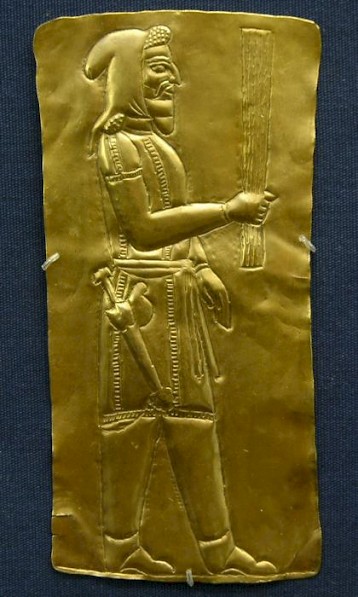
When discussing the Magians of ancient Persia, one thing should be clear from the very start: Magians have nothing to do with magic or wizardry. The confusion, however, is understandable or - in any case - very old. In the sixth century BCE, the Greek philosopher Heraclitus of Ephesus directed his prophecies
against the wanderers of the night: the Magians, the Bacchantes, the Maenads, and initiates. Heraclitus threatens them with tortures after death, he threatens them with fire, for what they believe to be initiations in the mysteries are in fact impious rites.note
Heraclitus' threats are well chosen, because, as we will see below, the Magians venerated fire and believed in rewards and punishments after death, which was a common religious idea in Iran.
This was the first time that the word "Magians" was used negatively. Later authors lumped the expression together with words like "charlatan" and "wizard" and gave the word its now common meaning. The famous Macedonian philosopher Aristotle of Stagira (384-322), who had not spent part of his life in Persia's western territories for nothing, felt himself forced to state explicitly "that the Magians neither know nor practice sorcery".note
Greek sources
An older contemporary of the Macedonian philosopher, the Athenian author Xenophon (c.430-c.355), who visited the Achaemenid Empire in 401, calls the Magians experts "in everything religious".note He also knows that the Magians sing hymns to the rising sun and all known gods.note
But our most important Greek source is Herodotus of Halicarnassus (c.480-c.425). In his Histories, he mentions the Magians several times, usually in connection with sacrifices.
As for ceremonial, when the Persians offer sacrifice to the deities [...], they erect no altar and kindle no fire. The libation, the flute music, the garlands, the sprinkled meal - all these things, familiar to us, they have no use for. But before a ceremony, a man sticks a spray of leaves, usually myrtle leaves, into his headdress, takes his victim to some open place and invokes the deity to whom he wishes to sacrifice. The actual worshipper is not permitted to pray for any personal or private blessing, but only for the king and for the general good of the community. (The actual worshipper is not permitted to pray for any personal or private blessing, but only for the king and for the general good of the community, of which he is himself a part.) When he has cut up the animal and cooked it, he makes a little heap of the softest green-stuff he can find, preferably clover, and lays all the meat upon it. This done, a Magian - a member of this caste is always present at sacrifices - utters an incantation over it in a form of words which is supposed to recount the birth of the gods. Then after a short interval the worshipper removes the flesh and does what he pleases with it.note
Other instances where Herodotus mentions the Magians as sacrificers are libations at Troy, a sacrifice of white horses, and offerings to sea gods.note As we will see below, the sacrificial practice is also attested in Persian sources. Herodotus also mentions the Magians as interpreters of omens and dreams.note Although the combination of expertise on the subjects of sacrifice and dreams/omens is not unusual in the ancient Near East, our Persian sources do not confirm that the Magians were active in the second capacity. This may, however, be due to the nature of these Persian sources: administrative texts.
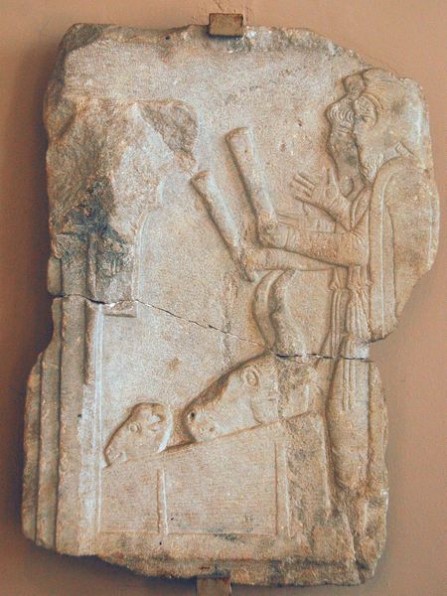
Herodotus also mentions two other customs.
There is a Persian practice concerning the burial of the dead, which is not spoken of openly and is something of a mystery: it is that a male Persian is never buried until the body has been torn by a bird or a dog. I know for certain that the Magians have this custom, for they are quite open about it. The Persians in general, however, cover a body with wax and then bury it.
The Magians not only kill anything, except dogs and men, with their own hands but make a special point in doing so; ants, snakes, animals, birds - no matter what, they kill them indiscriminately. Well, it is an ancient custom, so let them keep it.note
The existence of the burial custom can be corroborated. In later times, the Zoroastrians, the adherents of the prophet Zarathustra, exposed their dead to the vultures. (As we will see below, the Magians were Zoroastrians.) The killing of animals may have taken place near the fire altars, which had to remain ritually pure.
Persian sources
In Persepolis, the administrative capital of the Achaemenid empire, a large archive of administrative texts was found, the Persepolis fortification tablets. They can be dated in the reign of king Darius I the Great (522-486) and we learn that Magians were involved in the administration as accountants and controllers. It was a common practice in the ancient Near East to use religious officials as admistrators as well.
In these texts, the Magians are also mentioned in their religious capacities: they were responsible for the lan-sacrifice, for which Darius allotted every month 30 liters of barley or flour, fruits, and 10 liters of wine. It is the only type of sacrifice that is mentioned in connection to Persepolis.
Because the king was involved, this sacrifice as probably offered to Ahuramazda, the only god mentioned in Darius' texts. He was the supreme god of the Persians. In other words, the Magians - and not the priests - were responsible for the most important sacrifice in the state religion. This connection between the Magians and the cult of Ahuramazda is also suggested by the fourth-century author known as pseudo-Plato, who describes the teacher of young Persian noblemen:
He teaches the science of the Magians, owing to Zarathustra, son of Ahuramazda. It is in fact the worship of the gods.note
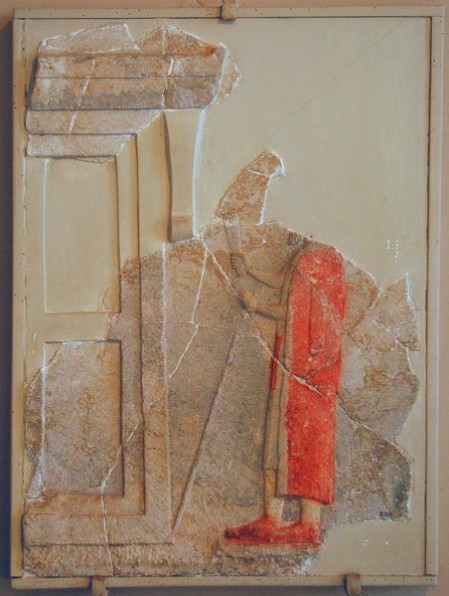
This short quote is interesting for another reason: it connects the activities of the Magians explicitly to Zoroastrianism (which is not necessarily the same as the cult of Ahuramazda). Since we are certain that Magians were involved in the state religion, the words of pseudo-Plato suggest that Zoroastrianism was the official cult of ancient Persia. This is, however, far from certain, and we should not rely too much on an author who believes that the prophet Zarathustra was the son of the god Ahuramazda.
The lan-sacrifice probably was a kind of fire sacrifice, because the Persepolis fortification tablets also call the Magians "fire kindlers". The Greek geographer Strabo of Amasia (64 BCE-c.23 CE) translates this as pyrethoi and is a more explicit about this ritual.
In Cappadocia - for there the sect of the Magians, who are also called fire kindlers, is large - they have fire temples [pyrethaia], noteworthy enclosures; and in the midst of these is an altar, on which there is a large quantity of ashes and where the Magians keep the fire ever burning. And there, entering daily, they make incantations for about an hour, holding before the fire their bundle of rods and wearing round their heads high turbans of felt, which reach down their cheeks far enough to cover their lips.note
The lips were probably covered to prevent their breath to pollute the fire. How one can sing in this way, is one of the unsolved mysteries of ancient religion.
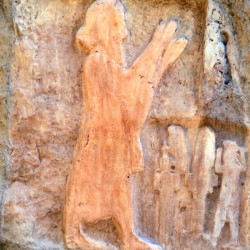 Eshaqvan, Rock Relief (cast at Taq-e Bostan) |
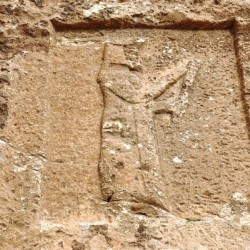 Dukkan-e Daud, Tomb, Relief of a Magian |
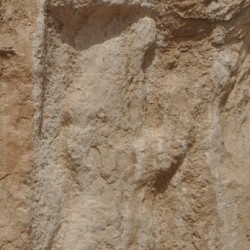 Naqš-e Rustam, Damaged relief of a Magian |
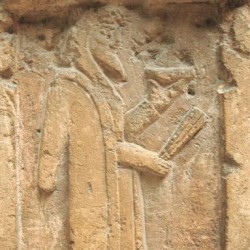 Relief of a magian with libation bowl and barsom |
From the holy book of Zoroastrianism, the Avesta, we know that the felt turban is called pâdam and the sacred twigs barsom. Another interesting observation is that the Magians are never mentioned in connection to non-Iranian gods in the Fortification tablets. Their only activities seem to have been the lan-sacrifice to Ahuramazda on behalf of the king and sacrifices to other Iranian gods. Probably, the other sacrifices were similar to those described by Herodotus.
History of the Magians
According to Herodotus, there were already Magians at the court of Astyages, the last leader of independent Media, who was defeated by the founder of the Achaemenid empire, Cyrus the Great (550 BCE). There is no reason not to believe this story, especially since there are two indications that the Magians were considered to be Medes. The first is a brief remark in Herodotus' Histories that the Magians were a Median tribe.note If this is correct, we may assume that this tribe was comparable to the Jewish Levites, who were also involved in religious duties.
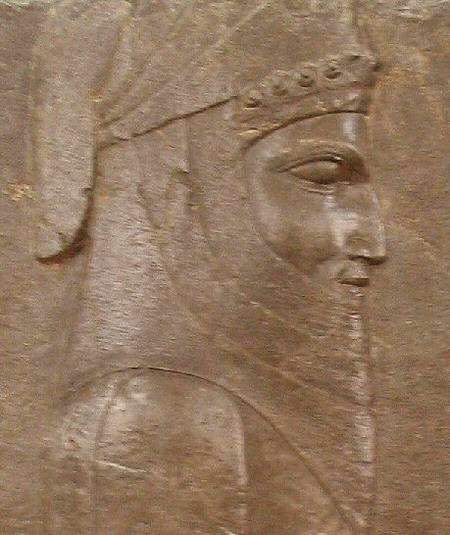
The second indication is the special status of the Median city Rhagae (near modern Tehran), which was regarded by the Zoroastrians as one of Ahuramazda's special creations and was governed by a Zoroastrian leader. The Arab geographer Yaqut ar-Rumi (1179-1229 CE), writes about this town and identifies the Zoroastrian leader with the first among the Magians.
Ustûnâwand [near Rhagae] is said to have been in existence for more than three thousand years, and to have been the stronghold of the Masmoghân of the land during the times of paganism. This word, which designates the high priest of the Zoroastrian religion, is composed of mas, "great", and moghân, which means "Magian".
These two indications, however, are not very strong and we should not put too much weight on them.
Another story that involves a Magian is the coup d'état of Gaumâta in 522 BCE. After a brief reign, he was killed by Darius the Great. It is not known what caused his rebellion, and we are probably wrong to assume a religious motive behind the coup. There is simply not enough evidence to prove anything.
The evidence of the Persepolis fortification tablets and the Greek authors allows us to give a description of the role of the Magians in the next two centuries. They were usually at the royal court, were employed in the bureaucracy, brought fire sacrifices, and performed other ceremonial duties. They accompanied the king on his campaigns and may have been consulted as interpreters of dreams and omens. If their position and function changed, our sources are insufficient to document it.
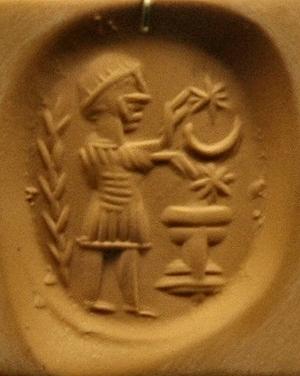
In the winter of 331/330, the Macedonian king Alexander the Great invaded Persia, and during the next months, he put an end to reign of the Achaemenid dynasty. Our Greek sources mention Magians at Alexander's court and we may asume that they were performing the usual incantations, prayers, and sacrifices. This proves that there was collaboration between at least some Magians and the conqueror.
However, it is equally certain that Alexander destroyed Zoroastrian sanctuaries, persecuted priests, and destroyed religious writings. According to one source, the "accursed Alexander" also "slew those who went in the garments of Magians" (go here for three texts on the subject). It seems that many Zoroastrians fled to Drangiana where they taught each other what they remembered of the correct rituals.
The Magians after Alexander
The conquests of Alexander did hardly improve western knowledge of eastern religion. In Greek and Latin sources, the Magians became simply the representatives of the eastern cults par excellence, and nobody was interested in the difference between a Magian, a Brahman, and a Chaldaean - they were all the same, although it was known that they were from three different countries, Persia, India, and Babylonia. However, their activities seemed interchangeable, at least from the first century CE onward. Therefore, the "wise men" mentioned in the Gospel of Matthew are called Magians, although the correct term for people observing celestial omens would have been Chaldaeans, mathematicians, or astrologers (Chaldaioi, mathematikoi or astrologoi).
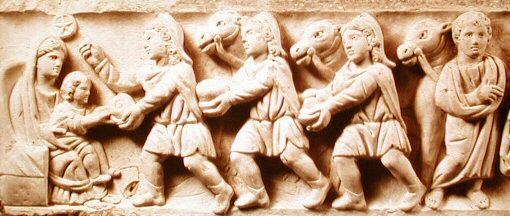
Meanwhile, in the east, the Magians played a role of some importance in the Parthian Empire (but there is hardly any information about it). In the third century, the Parthians were defeated by the Persians, who founded a second empire. The Sasanian king Ardašir conferred many privileges to the Magians, who gained great political power. For example, they played a role in the inauguration ceremony in Ctesiphon and served as judges and tax collectors.